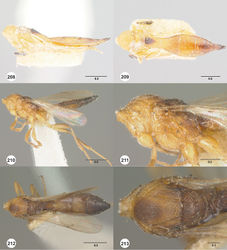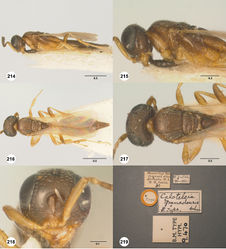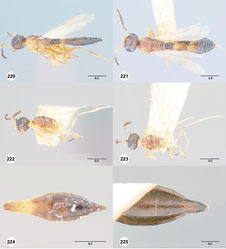Calliscelio rubriclavus
| Notice: | This page is derived from the original publication listed below, whose author(s) should always be credited. Further contributors may edit and improve the content of this page and, consequently, need to be credited as well (see page history). Any assessment of factual correctness requires a careful review of the original article as well as of subsequent contributions.
If you are uncertain whether your planned contribution is correct or not, we suggest that you use the associated discussion page instead of editing the page directly. This page should be cited as follows (rationale):
Citation formats to copy and paste
BibTeX: @article{Chen2017ZooKeys, RIS/ Endnote: TY - JOUR Wikipedia/ Citizendium: <ref name="Chen2017ZooKeys">{{Citation See also the citation download page at the journal. |
Ordo: Hymenoptera
Familia: Platygastridae
Genus: Calliscelio
Name
Calliscelio rubriclavus (Ashmead) comb. n. – Wikispecies link – ZooBank link – Pensoft Profile
- Acolus rubriclavus Ashmead, 1887: 99 (original description).
- Anteris nigriceps Ashmead, 1893: 225, 226 (original description); Muesebeck 1958[1]: 93 [junior synonym of Ceratoteleia marlatti (Ashmead)], syn. n. http://zoobank.org/9C37051A-432A-4772-A8EC-C1345A2F32D4 http://bioguid.osu.edu/xbiod_concepts/8446
- Caloteleia Marlattii Ashmead, 1893: 212, 214 (original description, keyed); Harrington 1900[2]: 187 (variation); Brues 1903[3]: 126 (emendation of male description), syn. n. http://zoobank.org/91C406E3-85AA-4C93-8CE5-D160876C5847 http://bioguid.osu.edu/xbiod_concepts/8445
- Caloteleia rubriclava (Ashmead): Ashmead 1893[4]: 212, 214 (generic transfer, description, keyed).
- Caloteleia grenadensis Ashmead, 1896: 798 (original description); Ashmead 1900[5]: 327 (distribution), syn. n. http://zoobank.org/E41DB9D7-F6E1-49BA-BB67-4C8A37430374 http://bioguid.osu.edu/xbiod_concepts/8437
- Ceratoteleia Marlatti (Ashmead): Kieffer 1908[6]: 121 (generic transfer, emendation).
- Ceratoteleia grenadensis (Ashmead): Kieffer 1908[6]: 121 (generic transfer); Kieffer 1926[7]: 501, 505 (description, keyed).
- Ceratoteleia rubriclava (Ashmead): Kieffer 1908[6]: 121 (generic transfer); Kieffer 1926[7]: 501, 504 (description, keyed).
- Prosanteris nigriceps (Ashmead): Kieffer 1908[6]: 136 (generic transfer); Kieffer 1926[7]: 437, 438 (description, keyed).
- Caloteleia rubriclavus (Ashmead): Brues 1908[8]: 33 (emendation).
- Prosanteris (Prosanteris) nigriceps (Ashmead): Kieffer 1910b[9]: 87 (subgeneric assignment).
- Caloteleia marlattii (Ashmead): Brues 1916[10]: 554 (description); Masner and Muesebeck 1968[11]: 33 (lectotype designation).
- Macroteleia ruskini Girault, 1920: 179 (original description); Muesebeck 1958: 93 [junior synonym of Ceratoteleia marlatti (Ashmead)], syn. n. http://zoobank.org/94B4FD7F-E840-437B-8E2B-46F87BE377DF http://bioguid.osu.edu/xbiod_concepts/8447
- Ceratoteleia marlattii (Ashmead): Kieffer 1926[7]: 501, 504 (description, keyed).
- Calotelea grenadensis (Ashmead): Masner 1965[12]: 70 (type information).
- Calotelea nigriceps (Ashmead): Masner and Muesebeck 1968[11]: 33 (type information).
- Calotelea rubriclava (Ashmead): Masner and Muesebeck 1968[11]: 33 (type information).
- Calotelea ruskini (Girault): Masner and Muesebeck 1968[11]: 33 (type information, generic transfer).
Description
Body length of female: 1.80–2.55 mm (n=20). Body length of male: 1.60–2.35 mm (n=20). Color of head: black throughout; brown throughout. Color of antennal clava (A7–A12): dark brown to black. Shape of head: subglobose. Central keel of frons: absent. Setation of upper frons: with sparse, short setae. IOS/EH: IOS slightly less than EH; IOS slightly greater than EH. Sculpture of ventrolateral frons: granulate. Sculpture of frons below median ocellus: granulate. Sculpture of posterior vertex: granulate. Hyperoccipital carina: absent. Occipital carina medially: complete, weakly crenulate throughout. Length of OOL: less than 0.5× ocellar diameter; greater than 0.5× ocellar diameter. Sculpture of postgena behind outer orbit: granulate. Ocular setae: absent. A4 in female: distinctly shorter than A3. A5 in female: shorter than A3, as long as wide. Shape of female A6: distinctly wider than long. Form of male antennal flagellomeres: filiform, A11 approximately 2.0× longer than wide. Length of A5 tyloid in male: greater than 0.5× length of A5.
Color of mesosoma in female: orange throughout; black throughout; variably orange to pale brown. Color of mesosoma in male: orange throughout; variably orange to pale brown; black throughout. Sculpture of dorsal pronotal area: rugose. Sculpture of lateral pronotal area: rugose throughout. Sculpture of netrion: rugose. Notaulus: percurrent. Sculpture of mesoscutum: granulate; densely punctate. Shape of mesoscutellum: semiellipsoidal. Foveolae of scutoscutellar sulcus between notauli: smaller than those along margin of axilla. Sculpture of mesoscutellum: granulate. Shape of metascutellum: posterior somewhat rounded or straight, approximately 3.0× wider than long. Sculpture of metascutellum in female: rugose. Sculpture of metascutellum in male: rugose. Dorsal propodeum in female: shallowly excavate medially, with lateral propodeal carinae widely separated. Sculpture of dorsal propodeum in female: rugose. Sculpture of dorsal propodeum in male: rugose. Median keels on propodeum in female: absent. Mesopleural carina: absent. Sculpture of mesepisternum below mesopleural depression: densely punctate. Sculpture of ventral metapleural area: smooth dorsally, densely punctate ventrally. Color of legs: orange throughout; pale brown. Sculpture of hind coxa: smooth.
Color of fore wing: hyaline. Rs+M: spectral. Setae on R: short, decumbent, hardly exceeding the margin of the wing. Length of R: distinctly shorter than r-rs. Length of R1: approximately as long as r-rs.
Color of metasoma in female: black; orange throughout; variably orange to pale brown. Color of metasoma in male: orange throughout; variably orange to pale brown; black throughout. Horn on T1 in female: large and distinct. Sculpture of T1 horn dorsally: granulate; rugose. Sculpture of posterior margin of T1 in female: longitudinally striate throughout. Sculpture of T1 in male: longitudinally striate. Development of longitudinal striae on T2 in female: reaching the middle of T2 medially; reaching posterior margin of T2. Sculpture of T3: smooth; largely smooth with submedian longitudinal striae; longitudinally striate throughout. Shape of T6 in female: short, slightly longer than wide. Sculpture of S3: smooth to coriaceous.
Diagnosis
This species is easily identified by the combination of the following characters: eye bare; occipital carina complete medially; mesopleural carina absent; mesepisternum below mesopleural depression densely punctate; ventral metapleural area densely punctate ventrally; R1 approximately as long as r-rs.
Link to distribution map
[http://hol.osu.edu/map-full.html?id=4169]
Material examined
Holotype, female, Calliscelio grenadensis: GRENADA: Saint George Parish, leeward side, Mount Gay Estate, no date, H. H. Smith, B.M. TYPE HYM. 9.470 (deposited in BMNH). Lectotype, male, C. Marlattii: UNITED STATES: Riley Co., V, Marlatt, USNMENT00989024 (deposited in USNM). Syntype, male, Anteris nigriceps: UNITED STATES: VA, Arlington Co., Arlington, no date, USNMENT00989028 (deposited in USNM). Holotype, female, Acolus rubriclavus: UNITED STATES: FL, Duval Co., Jacksonville, ocean beach, Jacksonville Beach (San Pablo), no date, Ashmead, USNMENT00989042 (deposited in USNM). Holotype, female, Macroteleia ruskini: UNITED STATES: IL, no date, USNMENT00989079 (deposited in USNM). Other material: (1106 females, 610 males) ARGENTINA: 11 females, 2 males, OSUC 534125–534131, 534437 (CNCI); OSUC 322989, 63153, 63155 (OSUC); OSUC 577255–577256 (UCRC). BAHAMAS: 2 females, 2 males, OSUC 458330–458331, 458383, 534560 (CNCI). BELIZE: 9 females, 3 males, OSUC 534193–534197, 534203, 534214–534218, 534222 (CNCI). BOLIVIA: 1 female, OSUC 534164 (CNCI). BONAIRE: 2 females, OSUC 458377, 458382 (CNCI). BRAZIL: 48 females, 15 males, OSUC 534527, 553607, 557180–557181, 557197, 557220, 557246, 557248, 557282–557283, 557337, 557342, 557349, 557361, 557375 (CNCI); OSUC 111348, 111698–111700, 111704–111705, 111714, 111810, 111938, 111957, 112073, 112184–112185, 112189–112190, 112194, 112792, 112797, 113088, 11925, 130662, 130709, 130719, 130755, 130849, 131119, 131431, 132407, 132409, 132411, 132413, 132420–132421, 132433, 132446, 133028, 133046, 133050, 133067, 133130, 134362, 137997, 138091, 232034, 367498, 374725, 413, 583202 (OSUC). CANADA: 156 females, 68 males, OSUC 531695–531708, 531710–531720, 531725, 531728–531733, 531802–531865, 531867–531872, 531874–531917, 532076, 532103, 532123–532129, 534491–534493, 534495–534498, 534500, 534504–534507, 534509–534512, 554065–554117 (CNCI). CHILE: 16 females, OSUC 458265, 534444–534445, 534447, 534449, 534451–534452, 534454, 534456–534458 (CNCI); OSUC 441184–441187 (INHS); OSUC 576993 (OSUC). COLOMBIA: 2 females, 3 males, OSUC 557535, 557537–557539, 557550 (CNCI). COSTA RICA: 24 females, 3 males, OSUC 232068–232069, 532463, 532468, 532494, 532537, 532539, 532569, 532656–532658, 532664, 532711–532716, 532726, 532765–532766, 532769, 532777–532778, 532792, 532925 (CNCI); OSUC 245767 (OSUC). CUBA: 20 females, 3 males, OSUC 458199, 458201–458202, 458204–458205, 458207–458211, 458367–458375, 458378, 534558, 534597–534598 (CNCI). DOMINICAN REPUBLIC: 38 females, CMNH-486,514, 490,550, 490,915 (CMNH); OSUC 458178, 458180–458182, 458184, 458186, 458188–458190, 458192, 458194, 458329, 458358–458366, 458376, 458381, 534362–534371, 534374, 534381 (CNCI). ECUADOR: 15 females, OSUC 458519, 458521–458523, 458528, 553368, 553431, 553433, 553601–553602, 553624, 553726–553729 (CNCI). FRENCH GUIANA: 4 females, OSUC 546113–546116 (CNCI). GUATEMALA: 2 females, 2 males, OSUC 534430–534433 (CNCI). HAITI: 2 females, OSUC 534548–534549 (CNCI). HONDURAS: 37 females, 2 males, OSUC 534145 (CNCI); OSUC 399364–399366, 399368–399372, 399374–399377, 399379–399382, 399386–399387, 399391, 399393, 399395, 399397–399399, 399401–399404, 399407, 399409, 401745, 410436–410438, 410441, 410444–410445, 410448 (MZLU). JAMAICA: 6 females, OSUC 458196–458197, 458379–458380, 534617–534618 (CNCI). KENYA: 1 female, OSUC 56760 (OSUC). MEXICO: 62 females, 44 males, OSUC 531739, 533998–534000, 534004–534012, 534014, 534024, 534464, 534472–534475, 534490 (CNCI); OSUC 410663–410680, 411743, 414931–414932, 49274, 49276, 55926, 583141–583201 (OSUC). NICARAGUA: 2 females, OSUC 534556–534557 (CNCI). PANAMA: 16 females, OSUC 553860–553871, 553873–553874, 553913–553914 (CNCI). PARAGUAY: 53 females, 8 males, OSUC 150605, 150607, 228804–228807, 276658–276659, 278828, 322986, 322994, 322996–322997, 323036–323037, 323039–323044, 323046–323047, 323049–323053, 323056–323057, 323061–323066, 323068–323070, 323072–323074, 363636, 363708–363710, 363713, 373987–373997, 534682, 534685, 577154 (OSUC). PERU: 2 females, 1 male, OSUC 554022 (CNCI); OSUC 583203–583204 (OSUC). SAINT LUCIA: 1 female, OSUC 534550 (CNCI). SOUTH AFRICA: 2 males, OSUC 223550–223551 (OSUC). SURINAME: 1 female, OSUC 534569 (CNCI). TRINIDAD AND TOBAGO: 66 females, 1 male, OSUC 545994–545996, 545998, 546000, 546004–546011, 546014–546022, 546034–546049, 546053–546056, 546059, 546061–546076, 546078–546081, 546083, 546087, 546091–546092 (CNCI). UNITED STATES: 484 females, 451 males, OSUC 531679–531681, 531683–531685, 531687–531694, 531709, 531721–531724, 531738, 531740–531749, 531751–531775, 531781–531785, 531787–531791, 531793–531801, 531866, 531919–531939, 531948–531980, 531982–532003, 532005–532034, 532037–532044, 532046, 532048–532060, 532062–532063, 532065, 532067–532075, 532078–532099, 532101–532102, 532104–532118, 532120, 532122, 532130, 532247–532303, 532305–532311, 532313–532339, 532391–532399, 532402–532457, 534501–534503, 534508, 554118–554150 (CNCI); OSUC 332917 (MEMU); OSUC 130442, 130451, 130453, 130460, 130462, 130465, 130474, 130477, 130479, 130488, 130491, 130497, 130499–130500, 130513–130515, 130544, 130574, 142758–142787, 142789–142804, 142806, 142808–142809, 142811–142812, 182700, 182725, 207789, 207795–207796, 236917–236918, 236920, 24231, 256432, 256450–256451, 256513–256517, 256536–256538, 256557–256558, 256595, 256634–256644, 256745–256768, 332914–332916, 336798–336804, 336806–336812, 336814–336818, 336966–336986, 336988–337018, 397539–397562, 397641–397650, 410662, 55872–55879, 55881–55889, 55891–55906, 576987–576989, 577075–577089, 582301–582320, 583121, 583123–583126, 583128–583140, 583315, 62475, 62495, 62498, 62593, 628906, 62893–62894, 62906, 79811–79812 (OSUC); UCFC 0 118 312, 539, 545, 653, 906, 972, UCFC 0 119 004, UCFC 0 119 183, UCFC 0 119 232, UCFC 0 119 419, UCFC 0 119 434, UCFC 0 120 030, UCFC 0 132 372, UCFC 0 133 615, UCFC 0 133 662, UCFC 0 133 711, UCFC 0 133 782, UCFC 0 133 892, UCFC 0 133 948, UCFC 0 134 479, UCFC 0 134 588, UCFC 0 134 768, UCFC 0 134 851, UCFC 0 134 882, UCFC 0 134 902, UCFC 0 134 963, UCFC 0 135 895, UCFC 0 136 236, UCFC 0 136 271, UCFC 0 136 716, UCFC 0 138 064, UCFC 0 138 130, UCFC 0 138 265, UCFC 0 138 491, UCFC 0 138 502, UCFC 0 138 634, UCFC 0 138 639, UCFC 0 138 772, UCFC 0 138 795, UCFC 0 138 873, UCFC 0 138 898, UCFC 0 138 975, UCFC 0 139 191, UCFC 0 139 197, UCFC 0 139 395, UCFC 0 139 500, UCFC 0 139 633, UCFC 0 139 715, UCFC 0 140 509, UCFC 0 141 638, UCFC 0 142 229, UCFC 0 142 314, UCFC 0 142 556, UCFC 0 142 751, UCFC 0 142 811, UCFC 0 142 817, UCFC 0 143 684, UCFC 0 143 743, UCFC 0 144 035, UCFC 0 144 069, UCFC 0 144 169, UCFC 0 144 180, UCFC 0 144 188, UCFC 0 144 293, UCFC 0 144 568, UCFC 0 144 723, UCFC 0 144 755, UCFC 0 144 878, UCFC 0 144 974, UCFC 0 165 080, UCFC 0 165 131, UCFC 0 165 138, UCFC 0 165 192, UCFC 0 165 195, UCFC 0 165 206, UCFC 0 165 253, UCFC 0 165 546, UCFC 0 165 794, UCFC 0 165 803, UCFC 0 165 808, UCFC 0 165 925, UCFC 0 165 945, UCFC 0 165 952, UCFC 0 166 051, UCFC 0 166 425, UCFC 0 166 683, UCFC 0 166 795, UCFC 0 167 268, UCFC 0 284 802, UCFC 0 319 189, UCFC 0 373 784, UCFC 0 373 785, UCFC 0 374 236, UCFC 0 374 613, UCFC 0 380 130, UCFC 0 380 135, UCFC 0 380 143, UCFC 0 380 144, UCFC 0 380 702, UCFC 0 381 255, UCFC 0 381 256, UCFC 0 389 068, UCFC 0 389 069, UCFC 0 389 076, UCFC 0 389 077, UCFC 0 389 101, UCFC 0 389 105, UCFC 0 389 106, UCFC 0 389 109, UCFC 0 390 859, UCFC 0 391 400, UCFC 0 391 900, UCFC 0 391 901, UCFC 0 392 443, UCFC 0 392 444, UCFC 0 392 447, UCFC 0 392 449, UCFC 0 392 834, UCFC 0 393 389, UCFC 0 393 402, UCFC 0 393 403, UCFC 0 393 871, UCFC 0 393 872, UCFC 0 393 873, UCFC 0 393 874, UCFC 0 393 875, UCFC 0 393 876, UCFC 0 393 877, UCFC 0 393 878, UCFC 0 393 879, UCFC 0 394 467, UCFC 0 394 622, UCFC 0 394 623, UCFC 0 394 624, UCFC 0 394 625, UCFC 0 394 847, UCFC 0 394 848, UCFC 0 395 201, UCFC 0 395 204, UCFC 0 395 485, UCFC 0 395 896, UCFC 0 395 985 (UCFC); OSUC 157686–157687, 157689–157691 (UCMC). VENEZUELA: 23 females, OSUC 545831, 545852, 545862–545863, 545869, 545936, 545948–545950, 546124–546126, 557669–557670, 557674–557675, 557678–557679, 557708, 557711 (CNCI); OSUC 48276, 49158, 64554 (OSUC).
Comments
This species seems to be a very common species in the New World, and we also have seen additional specimens from South Africa. Masner et al. (2009)[13] suggested that this kind of widespread distribution may result from commercial traffic. Calliscelio rubriclavus exhibits variation in color, ranging from orange to black, in the shape of metascutellum, and in the sculpture of T1 horn and T3. Specimens collected from Central America tend to be darker, while the variation in the sculpture of T1 horn and T3 show no clear correlations among the distrituion ranges
Taxon Treatment
- Chen, H; Masner, L; Johnson, N; 2017: New World species of the genus Calliscelio Ashmead (Hymenoptera, Platygastridae, Scelioninae) ZooKeys, (648): 1-136. doi
Images
|
Other References
- ↑ Muesebeck C (1958) Superfamily Proctotrupoidea. Pages 88–94 in Krombein K, Hymenoptera of America North of Mexico Synoptic Catalog (Agriculture Monograph No. 2), First Supplement. United States Government Printing Office, Washington, DC, 305 pp. https://doi.org/10.5962/bhl.title.63729
- ↑ Harrington W (1900) Catalogue of Canadian Proctotrypidae. Transactions of the Royal Society of Canada (2)5(4): 169–206. https://doi.org/10.5281/zenodo.23739
- ↑ Brues C (1903) Descriptions of new ant-like and myrmecophilous Hymenoptera. Transactions of the American Entomological Society 29: 119–128. https://doi.org/10.5281/zenodo.23616
- ↑ Ashmead W (1893) A monograph of the North American Proctotrypidae. Bulletin of the United States National Museum 45: 1–472. https://doi.org/10.5479/si.03629236.45.1
- ↑ Ashmead W (1900) Report upon the aculeate Hymenoptera of the islands of St. Vincent and Grenada, with additions to the parasitic Hymenoptera and a list of the described Hymenoptera of the West Indies. Transactions of the Royal Entomological Society of London 1900: 207–367. https://doi.org/10.5281/zenodo.23429
- ↑ 6.0 6.1 6.2 6.3 Kieffer J (1908) Revision des Scelionidae (Hyménoptères). Annales de la Société Scientifique de Bruxelles. Mémoires 32: 111–250. https://doi.org/10.5281/zenodo.23670
- ↑ 7.0 7.1 7.2 7.3 Kieffer J (1926) Scelionidae. Das Tierreich. Vol. 48. Walter de Gruyter & Co., Berlin, 885 pp.
- ↑ Brues C (1908) Hymenoptera. Fam. Scelionidae. Genera Insectorum 80: 1–59. https://doi.org/10.5281/zenodo.23624
- ↑ Kieffer J (1910b) Hymenoptera. Fam. Scelionidae. Addenda et corrigenda. Genera Insectorum 80: 61–112. https://doi.org/10.5281/zenodo.23671
- ↑ Brues C (1916) Serphoidea (Proctotrypoidea). Pages 529–577 in Viereck . The Hymenoptera or, wasp-like insects, of Connecticut. Guide to the Insects of Connecticut, Part III. Bull. State Geol. Nat. Hist. Surv. No. 22, 824 pp. https://doi.org/10.5962/bhl.title.4972
- ↑ 11.0 11.1 11.2 11.3 Masner L, Muesebeck C (1968) The types of Proctotrupoidea (Hymenoptera) in the United States National Museum. Bulletin of the United States National Museum 270: 1–143. https://doi.org/10.5479/si.03629236.270
- ↑ Masner L (1965) The types of Proctotrupoidea (Hymenoptera) in the British Museum (Natural History) and in the Hope Department of Entomology, Oxford. Bulletin of the British Museum (Natural History) Entomology Supplement 1: 1–154. https://doi.org/10.5281/zenodo.23697
- ↑ Masner L, Johnson F, Musetti L (2009) Calliscelio elegans (Perkins), a tramp species, and a review of the status of the genus Caenoteleia Kieffer (Hymenoptera: Platygastridae). Zootaxa 2237: 59–66.


